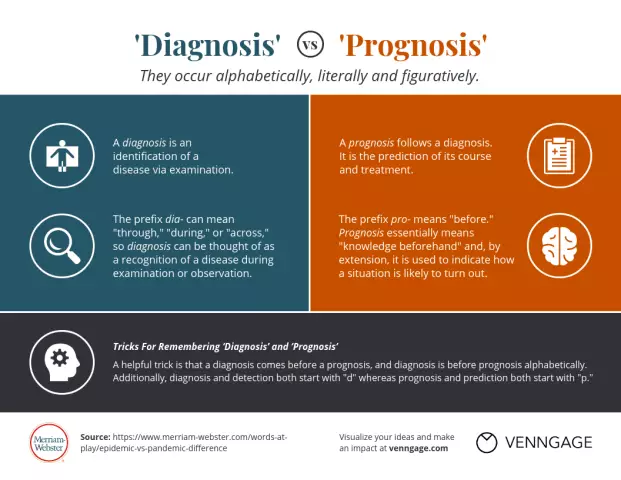- Author Rachel Wainwright [email protected].
- Public 2023-12-15 07:39.
- Last modified 2025-11-02 20:14.
Angiodystonia
Angiodystonia (vascular dystonia) is a violation of the tonic adaptive function of blood vessels, caused by a violation of the structure of the walls of blood vessels, as well as the development of the muscle layer, characterized by inadequacy, insufficiency or redundancy of function, which manifests itself as a regional (local) or general violation of blood flow. Angioedema can affect both arterial and venous vessels.

Vascular tone is the main function of the smooth muscles of the vascular wall, which provides the mechanical characteristics and geometric parameters of the walls and lumens of blood vessels.
Cerebral angiodystonia is a violation of the tonic function of the cerebral vessels, manifested by a characteristic symptomatic complex.
Angiodystonia is a disorder of vascular tone of various etiology (functional, organic), localization, development mechanism. Angiodystonia is not an independent disease, but in most cases acts as a concomitant (secondary) complex of symptoms, disorders caused by the underlying disease. Angiodystonia is observed against the background of the following diseases:
- Pathology of the endocrine glands (ovaries, adrenal glands, pituitary gland, thyroid gland);
- Dysfunction of the autonomic nervous system;
- Focal infections;
- Diseases of internal organs (amyloidosis, gastrointestinal diseases, pancreatitis, atherosclerosis and others);
- Diseases of the nervous system, head trauma, history of concussion;
- Allergic reactions;
- Hypodynamia;
- Chronic infectious processes;
- Features of the patient's personality (increased suspiciousness, irritability, a special degree of anxiety).
Angiodystonia is more common in adults, but recently it has been increasingly diagnosed in school-age children.
Angiodystonia is classified according to the following indicators:
- By etiology and pathogenesis, primary (neurogenic) and symptomatic angioedema are distinguished;
- Localization distinguishes between localized (monoregional) disorder and polyregional (systemic) angioedema;
- By the nature of the course, there are permanent disorders and angio-dystonic crisis;
- According to the arterial pressure, against the background of which a violation of the vascular tone develops, angiodystonia is distinguished against the background of normotension, disorders against the background of hypertension or against the background of hypotension.
Characteristic signs of angioedema
The main signs of angioedema are headaches of various nature and etiology, drops in blood pressure, dizziness, insomnia, numbness of the extremities, systematic tinnitus. A feeling of heaviness in the head develops. Some patients report memory impairment, impaired visual function, hearing, and smell. In some cases, symptoms of angioedema are pain in the limbs, neck, back.
Headache, which is a sign of angioedema, is localized in the temporal and temporo-parietal parts of the head. The pain can be dull, aching, shooting.
In rare cases, one of the possible symptoms of angioedema is depression, which is characterized by loss of control over the emotional state, difficulty breathing. Depression in angioedema develops against the background of a debilitating headache that disrupts the rhythm of a person's life. Headache is often not associated with fatigue or stress. Pain can occur at any time of the day, even after a long rest, at rest.
As a rule, the signs of angiodystonia appear in aggregate, which facilitates the diagnosis of the disorder.
Signs of angiodystonia when reading the results of clinical trials are:
- Change in the diameter and lumen of the vessel;
- Depletion of blood flow;
- Displacement of blood vessels.
Cerebral angiodystonia: consequences of the development of the disorder
Cerebral angiodystonia can develop both as a result of various disorders in the body (internal factors) and due to the influence of external factors (for example, stressful situations, eating heavy food).
Cerebral angiodystonia requires careful diagnosis. In the absence of adequate treatment against the background of angioedema, encephalopathy, a non-inflammatory brain disease, may develop. Encephalopathy against the background of cerebral angioedema is manifested by the following symptoms:
- Chronic depression;
- Frequent headaches due to stress, fatigue;
- Disorders of consciousness, memory;
- Dizziness;
- Lack of initiative.
Concomitant symptoms may also be increased fatigue, mood swings, heaviness in the head, sleep disturbance and other symptoms inherent in angioedema.
Angiodystonia: diagnosis of the disorder
If you suspect angiodystonia, a comprehensive examination is necessary. The main methods for diagnosing angiodystonia are non-invasive techniques, one of which is rheoencephalography - a study of cerebral vessels based on monitoring changes in tissue resistance values when exposed to weak electrical impulses of high frequency. Thus, it is possible to obtain objective information about the vascular apparatus of the brain: vascular tone, the reactivity of the cerebral vessels, the elasticity of their walls, the amount of pulse blood filling.
Also in the diagnosis of angioedema, the following methods are used:
- Ultrasound examination of arterial and peripheral vessels;
- Screening of ischemic changes in the myocardium using ECG.
Also, if angioedema is suspected, it is necessary to differentiate symptoms with signs of psychosomatic diseases.
Angiodystonia: treatment and prognosis
Angiodystonia is not an independent disease. This violation is of a secondary nature, developing against the background of other diseases, which determines the tactics of treatment for angioedema. So, first of all, with angiodystonia, treatment should be aimed at eliminating the underlying disease.

When diagnosed with angioedema, treatment should take place in the following directions:
- Determination and selection of the optimal therapy for the underlying disease that provokes the development of angioedema;
- Therapy aimed at normalizing vascular tone (for example, exercise therapy, aimed at training vascular reactions);
- Symptomatic treatment of angioedema;
- Lifestyle changes (normalizing sleep and rest, getting rid of bad habits, changing the diet).
Angiodystonia requires constant monitoring by the attending physician even in the complete absence of a symptomatic complex.
In rare cases, angiodystonia, the treatment of which should be complex, can cause a complete disability of the patient with a pronounced symptomatic complex. Currently, there are no criteria for choosing the optimal drugs for the treatment of the disorder and the elimination of symptoms. With angioedema, treatment is selected individually, taking into account the body's reactions to complex therapy.
The information is generalized and provided for informational purposes only. At the first sign of illness, see your doctor. Self-medication is hazardous to health!






